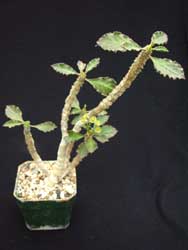
6404 Euphorbia capsaintemariensis grown from seed, three years old. Has upright, yellowish conical flower bracts.
|
|
#G01 Gasteria carinata var. verrucosa ex var Jaarsveld. Very long, narrow, and concave dramatically swept and curved, white-tuburculated, pointed leaves. A tinge of pink in the center in spring. This excellenet clone makes an impressive specimen plant. Not common. Offset.
|
|
#G02 Gasteria carinata var. verrucosa ex var Jaarsveld. Very long, narrow, and concave dramatically swept and curved, white-tuburculated, pointed leaves. A tinge of pink in the center in spring. This excellenet clone makes an impressive specimen plant. Not common. Clump.
|
|
#G03 Gasteria baylissiana ex Hammer. Arched, leathery dark grey-green, with leaves uniformly covered in minute white spots. When spring light light increases, leaf edges show a pinkish tinge. Clump.
|
|
#G04 Gasteria batesiana Barberton ex Hammer. Wide, flat, strap leaves radiate in full reddish-purple color low to the ground. Large, dramatic, pendulous flowers on arching bract. Offset.
|
|
Click here to send email
|
|
|

